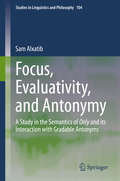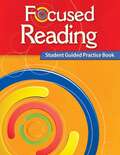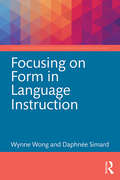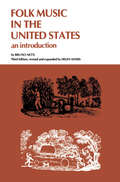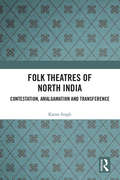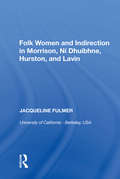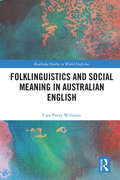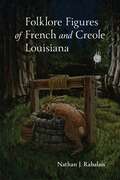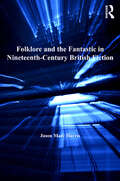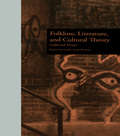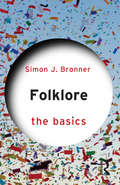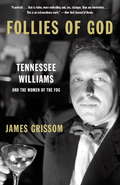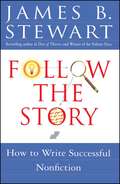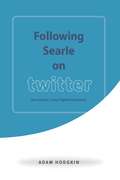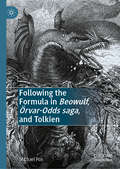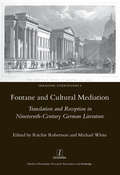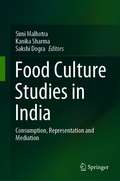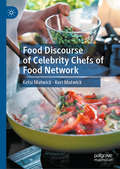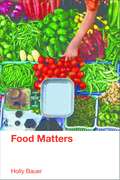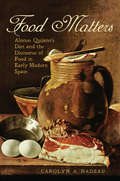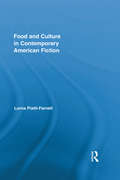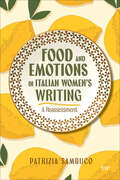- Table View
- List View
Focus, Evaluativity, and Antonymy: A Study in the Semantics of Only and its Interaction with Gradable Antonyms (Studies in Linguistics and Philosophy #104)
by Sam AlxatibThis book uncovers properties of focus association with 'only' by examining the interaction between the particle and bare (or “evaluative”) gradable terms. Its empirical building blocks are paradigms involving upward-scalar terms like 'few' and 'rarely', and their downward-scalar antonyms 'many' and 'frequently', an area that has not been studied previously in the literature. The empirical claim is that associations of the former type give rise to unexpected readings, and the proposed theoretical explanation draws on the properties of the latter type of association. In presenting the details, the book deconstructs the so-called scalar presupposition of 'only' and derives it from constraints against its vacuous use. This view is then combined with a semantics of the evaluative adjectives 'many' and 'few' to explain why the unavailable (but expected) meanings of the given constructions are unavailable. The attested (but unexpected) readings of 'only+few/rarely' associations are derived from independently motivated LFs in which the degree expressions are existentially closed. Finally, the book provides new findings, based on the core proposal, about 'only if' constructions, and about the interaction between 'only' and other upward-scalar modified numerals (comparatives, and 'at most'). The book thus provides new data and a new theoretical view of the semantic properties of 'only', and connects it to the semantics of gradable expressions.
Focused Reading Student Guided Practice Book Teacher Created Materials
by Teacher Created MaterialsFocused Reading Student Guided Practice Book Teacher Created Materials
Focusing on Form in Language Instruction (The Routledge E-Modules on Contemporary Language Teaching)
by Wynne Wong Daphnee SimardThis module on focusing on form in language instruction provides novice and experienced instructors with pedagogical techniques to help second language learners acquire formal elements of an L2. Taking the position that the development of a linguistic representation requires input, the pedagogical interventions presented in this module – textual enhancement, structured input, and dictogloss – all work with meaning-bearing input in some way. These techniques aim to increase the likelihood that learners focus on aspects of language useful or necessary for building mental representation. The module also discusses how explicit information may play a supporting role in helping learners process input. Please visit the series companion website for more information: http://routledgetextbooks.com/textbooks/9781315679594/
Folk Music in the United States: An Introduction
by Bruno NettlFolk Music in the United States gives readers a broad overview of many kinds of folk music found in this country, from the songs of rural Appalachia an d New England through the indigenous music of the American Indians and the African music brought by slaves, to the folk songs of European minorities. It traces the way folk music lives in the modern city, in the academic world, and in the contemporary music of American composers.The book introduces readers to the study of folk music as a kind of music and as an aspect of human culture. It uses music as an index to understanding American culture while it introduces readers to various concepts in the field of ethnomusicology.
Folk Stories from the Hills of Puerto Rico / Cuentos folklóricos de las montañas de Puerto Rico (Critical Caribbean Studies)
by Rafael Ocasio Kathleen LópezThis exciting new anthology gathers together Puerto Rican folktales that were passed down orally for generations before finally being transcribed beginning in 1914 by the team of famous anthropologist Franz Boas. These charming tales give readers a window into the imaginations and aspirations of Puerto Rico’s peasants, the Jíbaro. Some stories provide a distinctive Caribbean twist on classic tales including “Snow White” and “Cinderella.” Others fictionalize the lives of local historical figures, such as infamous pirate Roberto Cofresí, rendered here as a Robin Hood figure who subverts the colonial social order. The collection also introduces such beloved local characters as Cucarachita Martina, the kind cockroach who falls in love with Ratoncito Pérez, her devoted mouse husband who brings her delicious food. Including a fresh English translation of each folktale as well as the original Spanish version, the collection also contains an introduction from literary historian Rafael Ocasio that highlights the historical importance of these tales and the Jíbaro cultural values they impart. These vibrant, funny, and poignant stories will give readers unique insights into Puerto Rico’s rich cultural heritage. Esta nueva y emocionante antología reúne cuentos populares puertorriqueños que fueron transmitidos oralmente durante generaciones antes de ser finalmente transcritos comenzando en 1914 por el equipo del famoso antropólogo Franz Boas. Estos encantadores cuentos ofrecen a los lectores un vistazo a la imaginación y las aspiraciones de los jíbaros, los campesinos de Puerto Rico. Algunas historias brindan un distintivo toque caribeño a cuentos clásicos como "Blanca Nieves" y "Cenicienta". Otros ficcionalizan la vida de personajes históricos locales, como el famoso pirata Roberto Cofresí, representado como una figura al estilo de Robin Hood, quien subvierte el orden social colonial. La colección también presenta personajes locales tan queridos como Cucarachita Martina, la amable cucaracha que se enamora de Ratoncito Pérez, su devoto esposo ratón que le trae deliciosa comida. Incluyendo una nueva traducción al inglés de estos cuentos populares, así como las versiones originales en español, la colección también contiene una introducción del historiador literario Rafael Ocasio, quien destaca la importancia histórica de estos cuentos y los valores culturales del jíbaro que éstos imparten en los relatos. Estas historias vibrantes, divertidas y conmovedoras brindarán a los lectores una visión única de la rica herencia cultural de Puerto Rico. Introducción en español (https://d3tto5i5w9ogdd.cloudfront.net/wp-content/uploads/2021/02/03154419/Ocasio_Cuentos_Intro_Espan%CC%83ol.pdf)
Folk Theatres of North India: Contestation, Amalgamation and Transference
by Karan SinghThis book examines folk theatres of North India as a unique performative structure, a counter stream to the postulations of Sanskrit and Western realistic theatre. In focusing on their historical, social and cultural imprints, it explores how these theatres challenge the linearity of cultural history and subvert cultural hegemony. The book looks at diverse forms of theatre such as svangs, nautanki, tamasha, all with conventions like open performative space, free mingling of spectators and actors, flexibility in roles and genres, etc. It discusses the genesis, history and the independent trajectory of folk theatres; folk theatre and Sanskrit dramaturgy; cinematic legacy; and theatrical space as performance besides investigating causes, inter-relations within socio-cultural factors, and the performance principles underlying them. It shows how these theatres effectively contest delimitation of human creative impulses (as revealed in classical Sanskrit theatre) from structuring as also of normative impulses of religion and culture, while amalgamating influences from Western theatre, newly-rising religious reform movements of 19th century India, tantra and Bhakti. It further highlights their ability to adapt and reinvent themselves in accordance with spatial and temporal transformations to constitute an important anthropological layer of Indian society. Comprehensive and empirically rich, this book will be an essential read for scholars and researchers of cultural studies, theatre, film and performance studies, sociology, political studies, popular culture, and South Asian studies.
Folk Women and Indirection in Morrison, N�huibhne, Hurston, and Lavin
by Jacqueline FulmerFocusing on the lineage of pivotal African American and Irish women writers, the author argues that these authors often employ strategies of indirection, via folkloric expression, when exploring unpopular topics. This strategy holds the attention of readers who would otherwise reject the subject matter. The author traces the line of descent from Mary Lavin to Éilís Ní Dhuibhne and from Zora Neale Hurston to Toni Morrison, showing how obstacles to free expression, though varying from those Lavin and Hurston faced, are still encountered by Morrison and Ní Dhuibhne. The basis for comparing these authors lies in the strategies of indirection they use, as influenced by folklore. The folkloric characters these authors depict-wild denizens of the Otherworld and wise women of various traditions-help their creators insert controversy into fiction in ways that charm rather than alienate readers. Forms of rhetorical indirection that appear in the context of folklore, such as signifying practices, masking, sly civility, and the grotesque or bizarre, come out of the mouths and actions of these writers' magical and magisterial characters. Old traditions can offer new ways of discussing issues such as sexual expression, religious beliefs, or issues of reproduction. As differences between times and cultures affect what "can" and "cannot" be said, folkloric indirection may open up a vista to discourses of which we as readers may not even be aware. Finally, the folk women of Morrison, Ní Dhuibhne, Hurston, and Lavin open up new points of entry to the discussion of fiction, rhetoric, censorship, and folklore.
Folklinguistics and Social Meaning in Australian English (Routledge Studies in World Englishes)
by Cara Penry WilliamsFolklinguistics and Social Meaning in Australian English presents an original study of Australian English and, via this, insights into Australian society. Utilising folklinguistic accounts, it uncovers everyday understandings of contemporary Australian English through variations across linguistic systems (sounds, words, discourse and grammar). Focusing on one variation at time, it explores young speakers’ language use and their evaluations of the same forms. The analysis of talk about talk uncovers ethnic, regional and social Others in social types and prevailing ideologies around Australian English essential for understanding Australian identity-making processes, as well as providing insights and methods relevant beyond this context. These discussions demonstrate that while the linguistic variations may occur in other varieties of English, they are understood through local conceptualisations, and often as uniquely Australian. This book harnesses the value and richness of discourse in explorations of the sociocultural life of language. The findings show that analysis attending to language ideologies and identities can help discover the micro–macro links needed in understanding social meanings. The volume explores a wide range of language features but also provides a deep contemplation of Australian English.
Folklore Figures of French and Creole Louisiana
by Nathan RabalaisIn Folklore Figures of French and Creole Louisiana, Nathan J. Rabalais examines the impact of Louisiana’s remarkably diverse cultural and ethnic groups on folklore characters and motifs during the eighteenth and nineteenth centuries. Establishing connections between Louisiana and France, West Africa, Canada, and the Antilles, Rabalais explores how folk characters, motifs, and morals adapted to their new contexts in Louisiana. By viewing the state’s folklore in the light of its immigration history, he demonstrates how folktales can serve as indicators of sociocultural adaptation as well as contact among cultural communities. In particular, he examines the ways in which collective traumas experienced by Louisiana’s major ethnic groups—slavery, the grand dérangement, linguistic discrimination—resulted in fundamental changes in these folktales in relation to their European and African counterparts.Rabalais points to the development of an altered moral economy in Cajun and Creole folktales. Conventional heroic qualities, such as physical strength, are subverted in Louisiana folklore in favor of wit and cunning. Analyses of Black Creole animal tales like those of Bouki et Lapin and Tortie demonstrate the trickster hero’s ability to overcome both literal and symbolic entrapment through cleverness. Some elements of Louisiana’s folklore tradition, such as the rougarou and cauchemar, remain an integral presence in the state’s cultural landscape, apparent in humor, popular culture, regional branding, and children’s books. Through its adaptive use of folklore, French and Creole Louisiana will continue to retell old stories in innovative ways as well as create new stories for future generations.
Folklore and the Fantastic in Nineteenth-Century British Fiction
by Jason Marc HarrisJason Marc Harris's ambitious book argues that the tensions between folk metaphysics and Enlightenment values produce the literary fantastic. Demonstrating that a negotiation with folklore was central to the canon of British literature, he explicates the complicated rhetoric associated with folkloric fiction. His analysis includes a wide range of writers, including James Barrie, William Carleton, Charles Dickens, George Eliot, Sheridan Le Fanu, Neil Gunn, George MacDonald, William Sharp, Robert Louis Stevenson, and James Hogg. These authors, Harris suggests, used folklore to articulate profound cultural ambivalence towards issues of class, domesticity, education, gender, imperialism, nationalism, race, politics, religion, and metaphysics. Harris's analysis of the function of folk metaphysics in nineteenth- and early twentieth-century narratives reveals the ideological agendas of the appropriation of folklore and the artistic potential of superstition in both folkloric and literary contexts of the supernatural.
Folklore, Literature, and Cultural Theory: Collected Essays (New Perspectives in Folklore)
by Cathy Lynn PrestonFirst published in 1996. Routledge is an imprint of Taylor & Francis, an informa company.
Folklore: Folklore In The Creation Of American Tradition (The Basics)
by Simon J. BronnerFolklore: The Basics is an engaging guide to the practice and interpretation of folklore. Taking examples from around the world, it explores the role of folklore in expressing fundamental human needs, desires, and anxieties that often are often not revealed through other means. Providing a clear framework for approaching the study of folklore, it introduces the reader to methodologies for identifying, documenting, interpreting and applying key information about folklore and its relevance to modern life. From the Brothers Grimm to Internet Memes, it addresses such topics as: What is folklore? How do we study it? Why does folklore matter? How does folklore relate to elite culture? Is folklore changing in a digital age? With case studies, suggestions for reading and a glossary of key terminology, Folklore: The Basics supports readers in becoming familiar with folkloric traditions and interpret cultural expression. It is an essential read for anyone approaching the study of folklore for the first time.
Follies of God
by James GrissomAn extraordinary book; one that almost magically makes clear how Tennessee Williams wrote; how he came to his visions of Amanda Wingfield, his Blanche DuBois, Stella Kowalski, Alma Winemiller, Lady Torrance, and the other characters of his plays that transformed the American theater of the mid-twentieth century; a book that does, from the inside, the almost impossible--revealing the heart and soul of artistic inspiration and the unwitting collaboration between playwright and actress, playwright and director.At a moment in the life of Tennessee Williams when he felt he had been relegated to a "lower artery of the theatrical heart," when critics were proclaiming that his work had been overrated, he summoned to New Orleans a hopeful twenty-year-old writer, James Grissom, who had written an unsolicited letter to the great playwright asking for advice. After a long, intense conversation, Williams sent Grissom on a journey on the playwright's behalf to find out if he, Tennessee Williams, or his work, had mattered to those who had so deeply mattered to him, those who had led him to what he called the blank page, "the pale judgment." Among the more than seventy giants of American theater and film Grissom sought out, chief among them the women who came to Williams out of the fog: Lillian Gish, tiny and alabaster white, with enormous, lovely, empty eyes ("When I first imagined a woman at the center of my fantasia, I . . . saw the pure and buoyant face of Lillian Gish. . . . [She] was the escort who brought me to Blanche") . . . Maureen Stapleton, his Serafina of The Rose Tattoo, a shy, fat little girl from Troy, New York, who grew up with abandoned women and sad hopes and whose job it was to cheer everyone up, goad them into going to the movies, urge them to bake a cake and have a party. ("Tennessee and I truly loved each other," said Stapleton, "we were bound by our love of the theater and movies and movie stars and comedy. And we were bound to each other particularly by our mothers: the way they raised us; the things they could never say . . . The dreaming nature, most of all") . . . Jessica Tandy ("The moment I read [Portrait of a Madonna]," said Tandy, "my life began. I was, for the first time . . . unafraid to be ruthless in order to get something I wanted") . . . Kim Stanley . . . Bette Davis . . . Katharine Hepburn . . . Jo Van Fleet . . . Rosemary Harris . . . Eva Le Gallienne ("She was a stone against which I could rub my talent and feel that it became sharper") . . . Julie Harris . . . Geraldine Page ("A titanic talent") . . . And the men who mattered and helped with his creations, including Elia Kazan, José Quintero, Marlon Brando, John Gielgud . . . James Grissom's Follies of God is a revelation, a book that moves and inspires and uncannily catches that illusive "dreaming nature."From the Hardcover edition.
Follies of God: Tennessee Williams and the Women of the Fog
by James GrissomAn extraordinary book; one that almost magically makes clear how Tennessee Williams wrote; how he came to his visions of Amanda Wingfield, his Blanche DuBois, Stella Kowalski, Alma Winemiller, Lady Torrance, and the other characters of his plays that transformed the American theater of the mid-twentieth century; a book that does, from the inside, the almost impossible--revealing the heart and soul of artistic inspiration and the unwitting collaboration between playwright and actress, playwright and director.At a moment in the life of Tennessee Williams when he felt he had been relegated to a "lower artery of the theatrical heart," when critics were proclaiming that his work had been overrated, he summoned to New Orleans a hopeful twenty-year-old writer, James Grissom, who had written an unsolicited letter to the great playwright asking for advice. After a long, intense conversation, Williams sent Grissom on a journey on the playwright's behalf to find out if he, Tennessee Williams, or his work, had mattered to those who had so deeply mattered to him, those who had led him to what he called the blank page, "the pale judgment." Among the more than seventy giants of American theater and film Grissom sought out, chief among them the women who came to Williams out of the fog: Lillian Gish, tiny and alabaster white, with enormous, lovely, empty eyes ("When I first imagined a woman at the center of my fantasia, I . . . saw the pure and buoyant face of Lillian Gish. . . . [She] was the escort who brought me to Blanche") . . . Maureen Stapleton, his Serafina of The Rose Tattoo, a shy, fat little girl from Troy, New York, who grew up with abandoned women and sad hopes and whose job it was to cheer everyone up, goad them into going to the movies, urge them to bake a cake and have a party. ("Tennessee and I truly loved each other," said Stapleton, "we were bound by our love of the theater and movies and movie stars and comedy. And we were bound to each other particularly by our mothers: the way they raised us; the things they could never say . . . The dreaming nature, most of all") . . . Jessica Tandy ("The moment I read [Portrait of a Madonna]," said Tandy, "my life began. I was, for the first time . . . unafraid to be ruthless in order to get something I wanted") . . . Kim Stanley . . . Bette Davis . . . Katharine Hepburn . . . Jo Van Fleet . . . Rosemary Harris . . . Eva Le Gallienne ("She was a stone against which I could rub my talent and feel that it became sharper") . . . Julie Harris . . . Geraldine Page ("A titanic talent") . . . And the men who mattered and helped with his creations, including Elia Kazan, José Quintero, Marlon Brando, John Gielgud . . . James Grissom's Follies of God is a revelation, a book that moves and inspires and uncannily catches that illusive "dreaming nature."
Follow the Story: How to Write Successful Nonfiction
by James B. StewartAn indispensable guide to nonfiction writing from the Columbia Journalism School professor and Pulitzer Prize–winning journalist behind the bestsellers Blind Eye, Blood Sport, and Den of Thieves.In Follow the Story, bestselling author and journalist James B. Stewart teaches you the techniques of compelling narrative writing, from nonfiction books to articles, feature stories, or memoirs. Stewart provides concrete directions for conceiving, reporting, structuring, and writing nonfiction—techniques that he has used in his own successful books and stories. By using examples from his own work, Stewart illustrates systematically a way of thinking about and executing stories, a method that has helped numerous reporters and Columbia students become better writers. Follow the Story examines in detail: - How an idea is conceived - How to &“sell&” ideas to editors and publishers - How to report the nonfiction story - Six models that can be used for any nonfiction story - How to structure the narrative story - How to write introductions, endings, dialogue, and description - How to introduce and develop characters - How to use literary devices - Pitfalls to avoid Learn a clear way of looking at the world with the alert curiosity that is the first indispensable step toward good writing.
Following Searle on Twitter: How Words Create Digital Institutions
by Adam HodgkinTwitter allows us to build communities, track celebrities, raise our social profile, and promote a personal brand. Adam Hodgkin thinks Twitter is much more than a mere social media tool—it is a terrain ripe for a conceptual and theoretical analysis of our use of digital language. In Following Searle on Twitter, Hodgkin takes John Searle’s theory of speech acts as Status Function Declarations (SFDs)—speech acts that fulfill their meaning by saying the right words in the right context—as a probe for understanding Twitter’s institutional structure and the still-developing toolset that it provides for its members. He argues that Twitter is an institution built, constituted, and evolving through the use of SFDs. Searle’s speech act theories provide a framework for illuminating how Twitter membership arises, how users of Twitter relate to each other by following, and how increasingly complex content is conveyed with tweets. Using this framework, Hodgkin places language, action, intention, and responsibility at the core of the digital culture and the digital institutions that we are constructing. Combining theoretical perspective with a down-to-earth exposition of present-day digital institutions, Following Searle on Twitter explores how all of our interactions with these emerging institutions are deeply rooted in language, and are the true foundation of social media and contemporary institutions.
Following the Formula in Beowulf, Örvar-Odds saga, and Tolkien
by Michael FoxFollowing the Formula in Beowulf, Örvar-Odds saga, and Tolkien proposes that Beowulf was composed according to a formula. Michael Fox imagines the process that generated the poem and provides a model for reading it, extending this model to investigate formula in a half-line, a fitt, a digression, and a story-pattern or folktale, including the Old-Norse Icelandic Örvar-Odds saga. Fox also explores how J. R. R. Tolkien used the same formula to write Sellic Spell and The Hobbit. This investigation uncovers relationships between oral and literate composition, between mechanistic composition and author, and between listening and reading audiences, arguing for a contemporary relevance for Beowulf in thinking about the creative process.
Fontaine and Cultural Mediation: Translation and Reception in Nineteenth-Century German Literature
by Robertson RitchieIn the mid-1880s, the Realist author and Anglophile Theodor Fontane observed: �nowhere is so much translation done as in Germany.� Characterizing Germany as a special locus of literary translation and reception, Fontane contests a prejudice which has since become a significant problem for nineteenth-century German studies, namely the frequent assessment of the epoch as narrowly national. The present collection of essays by thirteen eminent literary scholars and historians is intended to correct this prejudice: it demonstrates that literary life and production in the nineteenth century were governed by complex networks of intercultural exchange, influence and translation, and it does justice to this complexity through its range of complementary critical approaches, focussing on Fontane, Anglo-German relations, translation, and European reception. In so doing, this book not only offers a nuanced appreciation of literary production and reception in the nineteenth century, but also demonstrates the continued relevance of that period for Germanists today.
Food Culture Studies in India: Consumption, Representation and Mediation
by Kanika Sharma Simi Malhotra Sakshi DograThis book discusses food in the context of the cultural matrix of India. Addressing topical issues in food and food culture, it explores questions concerning the consumption, representation and mediation of food. The book is divided into four sections, focusing on food fads; food representation; the symbolic valence of food; modes and manners of resistance articulated through food. Investigating consumption practices in both public and ethnic culture, each chapter introduces a fresh approach to food across diverse literary and cultural genres. The book offers a highly readable guide for researchers and practitioners in the field of literary and cultural studies, as well as the sociological fields of food studies, body studies and fat studies.
Food Discourse of Celebrity Chefs of Food Network
by Kelsi Matwick Keri MatwickFood Discourse explores a fascinating, yet virtually unexplored research area: the language of food used on television cooking shows. It shows how the discourse of television cooking shows on the American television channel Food Network conveys a pseudo-relationship between the celebrity chef host and viewers. Excerpts are drawn from a variety of cooking show genres (how-to, travel, reality, talk, competition), providing the data for this qualitative investigation. Richly interdisciplinary, the study draws upon discourse analysis, narrative, social semiotics, and media communication in order to analyze four key linguistic features – recipe telling, storytelling, evaluations, and humor – in connection with the themes of performance, authenticity, and expertise, essential components in the making of celebrity chefs. Given its scope, the book will be of interest to scholars of linguistics, media communication, and American popular culture. Further, in light of the international reach and influence of American television and celebrity chefs, it has a global appeal.
Food Matters
by Holly BauerFood Matters, Second Edition, explores questions about the seemingly simple concept of food: What is the purpose of food: sustenance, pleasure, health? How does what we eat determine and reflect our identities? What political, social, and cultural forces affect our food choices? What does it mean to eat ethically? What is food, exactly, and how do advances in technology affect our definition of it? Readings by a range of essayists, scientists, linguists, journalists, farmers, artists, and ordinary citizens take up these questions and more. Questions and assignments for each selection provide a range of activities for students. This new edition of Food Matters features current readings that reflect the evolving conversation about food in our society. The Bedford Spotlight Reader Series is an exciting line of single-theme readers, each reflecting Bedford’s trademark care and quality. An editorial board of a dozen compositionists at schools with courses focusing on specific themes assists in the development of the series. Each reader collects thoughtfully chosen selections sufficient for an entire writing course—about 35 pieces—to allow instructors to provide carefully developed, high-quality instruction at an affordable price. Bedford Spotlight Readers are designed to help students from all majors make sustained inquiries from multiple perspectives, opening up topics such as money, food, border crossings, music, humor, subcultures, happiness, monsters, sustainability, and gender to critical analysis. The readers are flexibly arranged in thematic chapters, with each chapter focusing in depth on a different facet of the central topic. The website for the Spotlight Series offers comprehensive instructor support with sample syllabi and additional teaching resources.
Food Matters: Alonso Quijano's Diet and the Discourse of Food in Early Modern Spain
by Carolyn A. NadeauIn the second sentence of Don Quixote, Cervantes describes the diet of the protagonist, Alonso Quijano: "A stew made of more beef than mutton, cold salad on most nights, abstinence eggs on Saturdays, lentils on Fridays, and an additional squab on Sundays."Through an inventive and original engagement with this text, Carolyn A. Nadeau explores the shifts in Spain's cultural and gastronomic history. Using cooking manuals, novels, poems, dietary treatises, and other texts, she brings to light the figurative significance of foodstuffs and culinary practices in early modern Spain. Drawing on the work of Pierre Bourdieu and Stephen Mennell, Food Matters reveals patterns of interdependence as observed, for example, in how Muslim and Jewish aversion to pork fired Spain's passion for ham, what happened when New World foodstuffs entered into Old World kitchens, and how food and sexual urges that so often came together, regardless of class, ethnicity, or gender, construct moments of communal celebration.This mouth-watering tour of the discourses of food in early modern Spain is complemented by an appendix that features forty-seven recipes drawn from contemporary sources.
Food and Culture in Contemporary American Fiction (Routledge Studies in Contemporary Literature)
by Lorna Piatti-FarnellEstablishing an interdisciplinary connection between Food Studies and American literary scholarship, Piatti-Farnell investigates the significances of food and eating in American fiction, from 1980 to the present day. She argues that culturally-coded representations of the culinary illuminate contemporary American anxieties about class gender, race, tradition, immigration, nationhood, and history. As she offers a critical analysis of major works of contemporary fiction, Piatti-Farnell unveils contrasting modes of culinary nostalgia, disillusionment, and progress that pervasively address the cultural disintegration of local and familiar culinary values, in favor of globalized economies of consumption. In identifying different incarnations of the "American culinary," Piatti-Farnell covers the depiction of food in specific categories of American fiction and explores how the cultural separation that molds food preferences inevitably challenges the existence of a homogenous American identity. The study treads on new grounds since it not only provides the first comprehensive study of food and consumption in contemporary American fiction, but also aims to expose interrelated politics of consumption in a variety of authors from different ethnic, cultural, racial and social backgrounds within the United States.
Food and Emotions in Italian Women's Writing: A Reassessment (Toronto Italian Studies)
by Patrizia SambucoFood and Emotions in Italian Women’s Writing discusses the relevance of food imagery in the writing of Italian women over a period of one hundred years, from the 1920s to the present day, while offering new ways to narrate women’s history and creativity. In this groundbreaking work, Patrizia Sambuco shows how food imagery in different historical periods challenge established political discourses by conveying unexpressed, alternative, or transgressive emotions. Through literary analysis, archival research, and philosophical approaches to the senses, emotions, and food, the book considers a variety of authors, from the celebrated to the hardly known. Sambuco argues that in different ways, throughout the decades, the conceptual domain of food has helped express forms of selfhood that push the boundaries of womanhood and interact with cultural and political panoramas at national and international levels. Building an alternative history of Italian women and their creativity, Sambuco shows how the interplay of the senses and emotions becomes a profitable way to illuminate overlooked aspects of women’s subjectivity. Food and Emotions in Italian Women's Writing ultimately reassesses women’s writing, giving value to the marginality of women’s bodies and positions through the conceptual domain of food.
